|
By
the early 1880s, the Winchester Model 1873 rifle and the Colt Single Action Army Revolver represented the state-of-the-art
personal arms of the western frontier and elsewhere.
The short, low- pressure Winchester Center Fire
cartridges of the 1873 lent themselves well to
interchangeability. The .44 WCF set the trend being very well
received in the Colt Frontier Six-shooter so, in 1884, Colt
began chambering the Single Action Army for the 38-40 and .32-20
as well.
The
overall handiness of the concept kept the WCF rounds popular
into the second third of the 20th Century.
Colt production figures as recorded by R.L. Wilson
(Colt,
An American Legend) indicate that of the 310,386 (not
including Flat top target, Bisley, etc.) first generation Single Action Army revolvers produced, 29,802
were chambered for the 32-20. The original loading was a nominal
20 grains of black powder behind a lead 117- grain bullet.
Actual factory loads ranged from the rather anemic rounds suited
to both revolver and rifle to the later factory high velocity
loads that were reported to be dangerous if fired in a revolver.
Current hand loads often approach the .30 carbine in
pressure and velocity while older references indicate that the
original rounds often contained less than the claimed 20 grains
of black.
The
.32-20 revolvers enjoyed some popularity in the remnants of the
American Frontier. Elmer Keith made early, frequent reference to the
round and records that his father was quite disgusted with him
when he traded a .22 rifle for one of these “pop-guns.”
He modified his stance considerably when Elmer collected
a few cottontails for the table.
Johnny
Bates’ .32-20 was manufactured in 1918 and was one of four
shipped to Wyeth Hardware & Mfg. Co., St. Joseph, MO on Oct
2, 1919.
The
revolver has resided, sans grips, in the bottom of Bates’ gun
safe since 1992. He has some elephant ivory ear-marked for the
revolver but, lacking the time for grip making, he attached a
set of modern eagle patterns for our shooting session.
The revolver has a 4 ¾” ejector rod length barrel
often called the “civilian” or “gunfighter” model.
It is very mechanically sound with new looking bore and
chambers. The
trigger pull, typical of first generation SAAs, was quite heavy
until Bates put a leather shim between spring and frame,
reducing the trigger release and creating the perfect imitation
of a custom tuned Colt. Much of the original blue and traces of
casehardening remain. The
sights are of the old pattern – u-notch and narrow blade.
Our load was the traditional flat point 115 grain plain
base bullet- these coming from a Lyman 3118 mold .313 as-cast
and tumble lubed –over 3 grains of Bullseye. Five rounds
averaged 761 fps with a 49fps extreme spread.
Our
shooting range is a mesquite patch not far from Ft Parker,
Texas. Special
conditions included a side wind that gusted twenty miles per
hour and did not augur well for pretty groups.
We did some close range shooting that established point
of impact as center for windage and a bit low.
Bates had brought along a CD/ROM from a notorious
Internet service and I proceeded to doctor this standing, two
handed from a paced off 25 yards.
One round was a narrow miss but the other four landed in
a surprisingly nice 3” spread with two of the rounds printing
a figure eight.
Giving
in to the buffeting wind, I sat down and rested my back against
a mesquite and tried to lay in a photogenic 25- yard group.
Nothing doing. Four
shots hit the 6” black but the tree was moving with the wind
and I threw one round out at six o’clock.
Disgusted, I stood up and fired four off-hand rounds from
the traditional NRA one- handed stance. Point of aim was 12
o’clock about 1” over the black.
I fully expected the results to resemble the efforts of a
paint sniffer trying to pitch a baseball but the excellent
trigger and a bit of luck came to my rescue and the rounds
landed in a tight little group.
I needed two more rounds to print a full ten in the black
and these landed in the same happy little clump.
Several
observations emerge from shooting this and other well preserved
Colt Single Actions of the first generation.
The original sights, which gave way to a square notch and
wider front blade during the 1920s, provide little or no
hindrance to decent shooting- as long as visual correction and
good lighting allow you to see them. The value of a crisp, light
trigger cannot be overstated.
Given the action set-up for a smooth, surprise release,
the Single Action Army hangs steady on target as the hammer
describes its long arc toward ignition. It is easy to call the
shots and the revolvers are fairly forgiving of shooting errors.
Parts breakage is a rare (and generally easily repaired)
occurrence- giving rise to the conjecture that the Colt
metallurgy was better than that of the present day foreign
replicas. While
oddball barrel, throat and chamber measurements are common in
the first generation Colts, it is not unusual to find them
displaying accuracy equal to the most modern designs.
Mike Cumpston
  
Got something to say about this article? Want to agree (or
disagree) with it? Click the following link to go to the GUNBlast Feedback Page.
All content © 2003 GunBlast.com.
All rights reserved. |
|
Click pictures for a larger version.
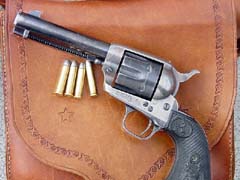
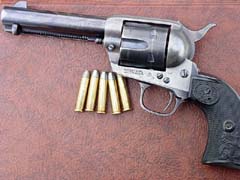
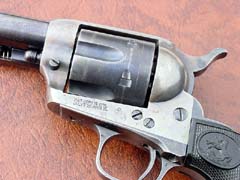
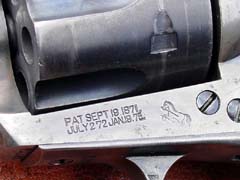
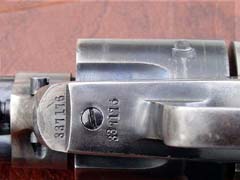
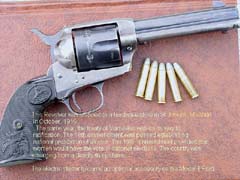
This revolver was shipped to a hardware
store in St. Joseph, Missouri in October, 1919.
The same year, the Treaty of Versailles
was on its way to ratification. The 18th Amendment was passed
establishing national prohibition of alcohol. The 19th
Amendment provided that women would have the vote in national
elections. The country was emerging from a deadly flu
epidemic. The electric starter became an optional accessory on
the Model T Ford.
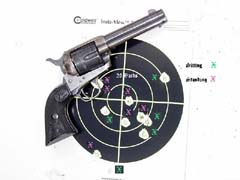
The old Colt can still shoot!
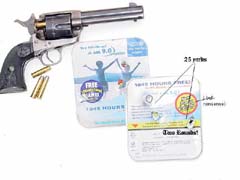
We're glad to see Mike found a use for
those Internet Service Provider CD-ROMs!
|
![]()